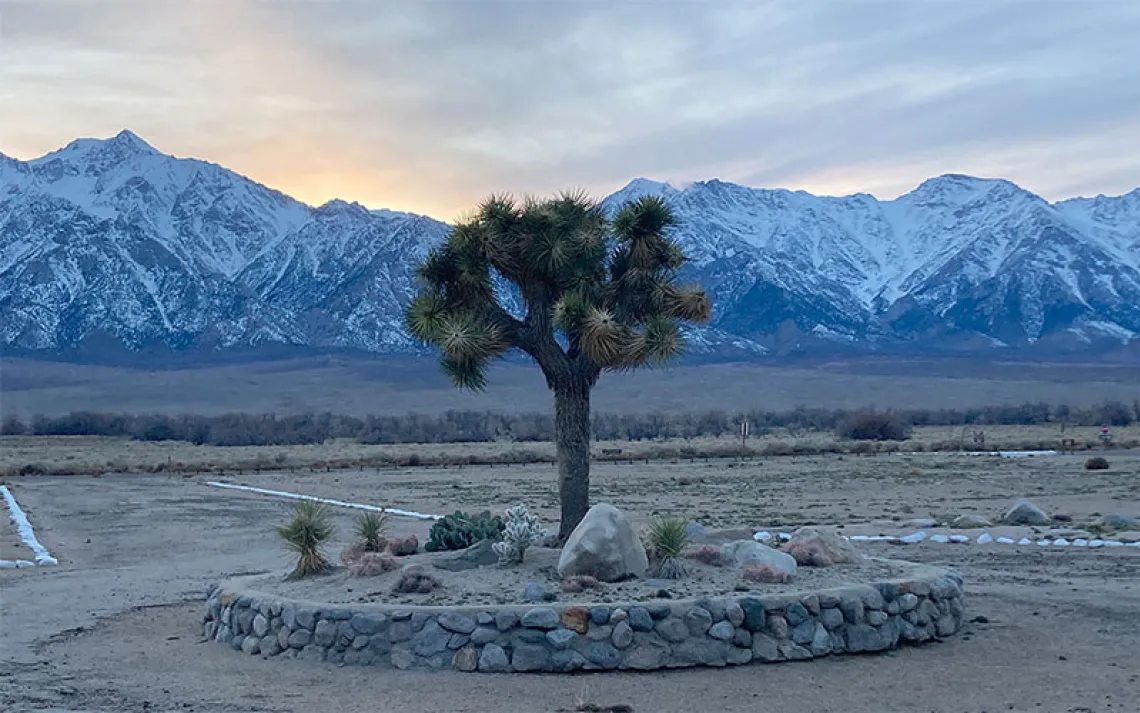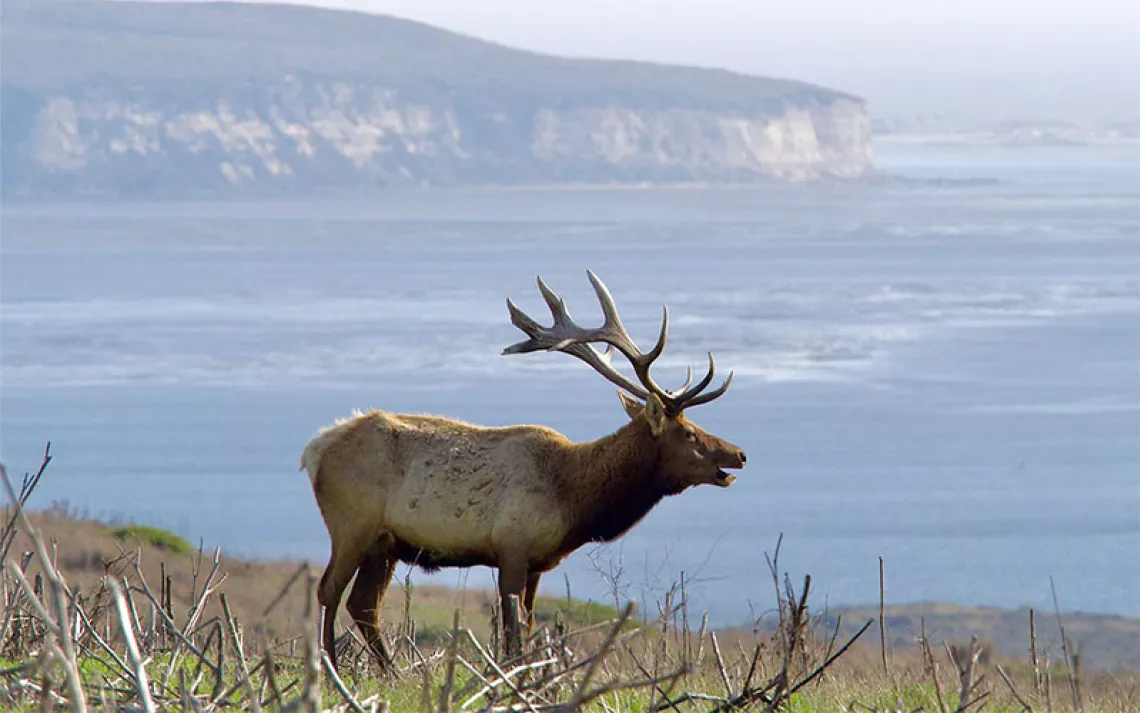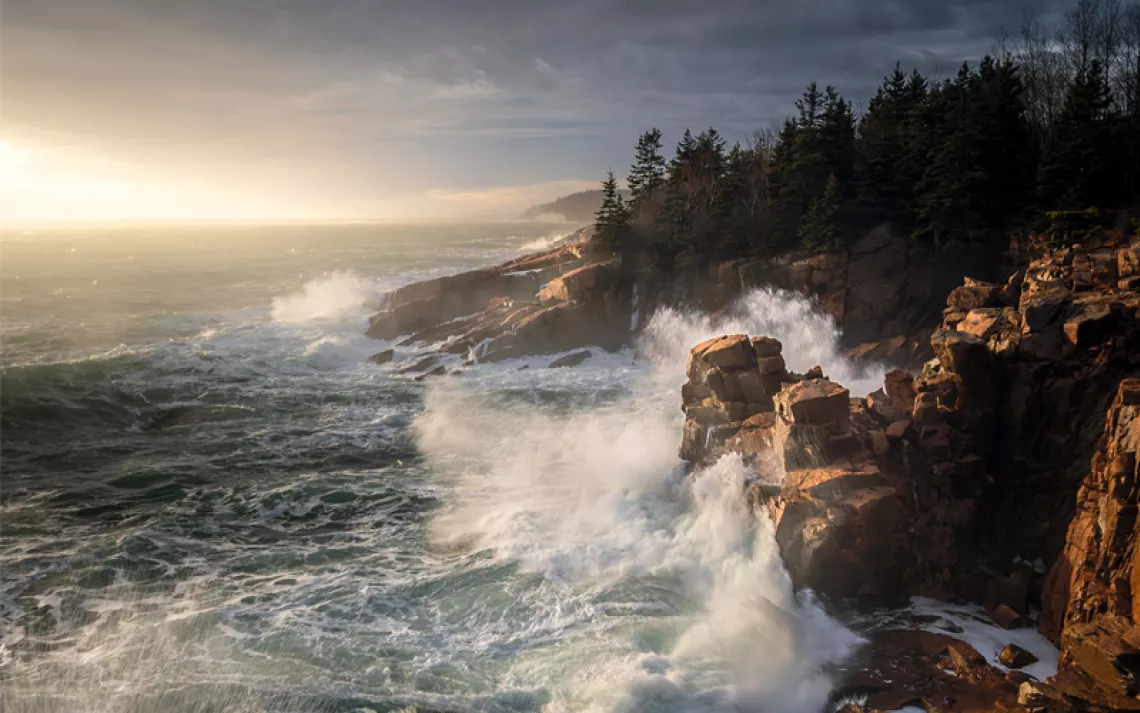Welcome to Yosemite’s Chinese Laundry Building
Inside the new monument to Chinese Americans’ contributions to the making of one of America’s most iconic natural expanses

Yosemite ranger Yenyen Chan highlights the park’s Chinese American history for visitors.
|Photos by Al Golub
It was October 1, 2021—Yosemite’s 130th anniversary of being designated a national park—and the Sierran valley was so thickly shrouded in smoke from recent wildfires that the silhouettes of the valley’s famed granite monuments faded into hazy outlines, Half Dome effectively reduced to Five Percent Dome. Yet no amount of smoke could keep a collection of 100-plus excited visitors from gathering near an old wood-shingled building just north of the Wawona Hotel. Their mission: to commemorate the opening of the Yosemite Chinese Laundry Building.
Yosemite’s brown-hatted interpretive rangers and Yosemite Conservancy members joined dozens of Asian Americans waving signs that read “Thank you, National Park Service, for telling our story!” The humble structure at the center of the festivities looked like it had been standing in the forest for more than century—because, well, it has. It originally functioned as a hand-laundry building where Chinese workers cleaned and pressed clothing and hotel linens for the Washburns, the family that originally owned the Wawona Hotel. The building went on to serve as a laundering nexus for future fancy park lodgings until it fell into disuse.

In fact, until a few years ago, the structure was filled with a strange mishmash of park detritus—an old stagecoach, a couple of wooden washboards, a 19th-century metal bin—essentially functioning as a dumping ground for unwanted Yosemite relics. “Full of junk,” recalls Sabrina Diaz, then Yosemite’s chief of interpretation and education. In 2017, Diaz took Chinese American hikers on a pilgrimage to see the building. “I walked through it, and I felt ashamed. Here was how we were protecting Chinese American history.” And yet that painful moment sparked major interest in revitalizing the space for the Chinese Laundry Building and making it a permanent monument to the Chinese workers in the High Sierras. “Half Dome and El Capitan—we don’t need any signage to tell us about what they are,” said Ranger Adam Ramsey, standing before the building on opening day. But the structure, he added, “has a lot to say. It tells the story of the people who made the park what it is today.”
***
What exactly had the Chinese contributed to the making of one of America’s most iconic natural expanses? Chinese American Yosemite ranger Yenyen Chan took the stage to explain to the crowds an epic multi-century story based on her tenacious research: When gold was discovered in California in 1848, Chinese immigrants arrived on American Pacific shores in sizable numbers, hoping to stake claim to the place they renamed Gum Jong, or Gold Mountain. During the scramble to find the precious metal, prospectors “discovered” Yosemite—although, of course, Native Americans had been living there for millennia. Tourists from all parts of the nation then flocked to see the Valley’s granite monuments and waterfalls, and the Giant Sequoias of Mariposa Grove, but the arduous journey to each natural wonder left visitors dusty, sore, and ragged.

As a result, a group with business interests in Yosemite decided to have two stagecoach roads built. That’s when word of attendant work possibilities spread among the Chinese immigrants of California, who had grown disillusioned with gold prospecting.
In 1850, the US government levied a tax on foreign miners, which, along with the dwindling natural supplies of gold, transformed mining into a losing proposition. What’s more, as prospectors, the Chinese faced severe hostility—and, on occasion, robbery and assault. They searched for other work to support their families back in China, and some found their way to Yosemite. In the 1870s, some 300 of them turned toward building roads around Yosemite. In the winter of 1874 through 1875, for example, the owners of the Wawona Hotel hired Chinese workers to construct Wawona Road so that the hotel could welcome tourists the following spring and summer. It did not seem to matter that blizzards pummeled the Sierras. The Chinese carved the thoroughfare, sometimes using blasting powder and handheld picks to cut through solid rock. They worked in the bitter frost, sleeping in tents. Less than a decade later, in 1882, some 250 Chinese and 90 Americans of European descent began working on a 56-mile road that led from Crocker’s Station, at 4,200 feet above sea level, to Tioga Pass, at 9,945 feet. The Chinese were paid $1.20 per day, while the European Americans made $1.50 per day. It was during this period that Mark Twain famously described the Chinese as being “as industrious as the day is long.” He added, “A disorderly Chinaman is rare, and a lazy one does not exist.”
And yet, despite these Chinese contributions to the building of America, Congress passed the Chinese Exclusion Act in 1882 to prevent any more Chinese from entering the United States in search of employment. That law, which was supposed to be in place for only 10 years, was extended numerous times. It blocked Chinese immigration to America for 60 years.
***
It’s likely that none of Yosemite’s Chinese history would have come to light had it not been for the fateful summer when Chan, then a Yale student, interned with the National Park Service in Yosemite. Her supervisor showed her a grainy black-and-white photograph of Chinese workers building the original Tioga Road to Tuolumne Meadows, and the image floored her. After graduate school in environmental studies, Chan worked in a number of environmentally focused jobs, earned a master’s, and then joined the Park Service as a ranger in 2003. Three years later, she began to research the Chinese workers’ lives in earnest, and has been lecturing publicly about their legacy since. “The story of Chinese Americans in Yosemite had been lost, and it’s never been highlighted until recently,” she says. “The Chinese are a big part of the park’s early history, and that’s a big source of pride.”
At the Chinese Laundry Building ceremony, Chan highlighted the country’s anti-Chinese racism, including the Chinese Exclusion Act, and said, “No wonder I was surprised to learn about Yosemite’s Chinese history and their contributions. Their history was almost erased from our country’s memory.” It was at that point that a few in the audience dabbed at their eyes with tissues. Chan, meanwhile, beamed a smile, and said, “And yet today, we are honoring this history with the opening of this new exhibit at a historical building—the original Chinese laundry building for the Wawona Hotel.”
Wandering through this former hand-laundry shop is like tiptoeing into the late 1800s: a range of experiences transport visitors into the Chinese workers’ daily labor, as well as the personal trials the Chinese might have faced in emigrating to California during the late 19th century.
Among the displays are panels showcasing historic photographs and Chinese-made artwork found in the park over a century ago. Chan’s favorite: a 1915 photo of the beloved backcountry cook Tie Sing with Stephen T. Mather and the Mather Mountain Party. “He is standing in the direct center of the photo,” says Chan. “Everyone is nicely dressed and smiling as they enjoy an elegant meal prepared by Tie Sing under a forest of towering trees.”

Make every day an Earth Day
Get articles like this one sent directly to your inbox.
With this action you affirm you want to receive Sierra Club communications and may vote on policy designated by the Sierra Club Board.
The building is set up as it might have been in the early 1900s, with an old iron stove, like the ones used to boil water for cleaning clothes, a laundry line with period clothing pinned across it, a rickshaw, and a two-wheel wooden pushcart used for the era’s construction projects.
Inspired by Chan’s decades-long research, Yosemite’s interpretive rangers (as their title suggests, they “interpret” the actions that occurred in the park over the centuries and determine what moments get woven into the park’s history) have created interactive activities for visitors. You can try your hand at using a Chinese seal (a.k.a. “chop”) and Chinese calligraphy brush and ink to learn more about some of the cultural traditions and practices of Chinese people. As Chan explains, “In early Chinese laundries in America, after finishing a piece of laundry, a small piece of paper was attached with words written in Chinese calligraphy.”
Visitors can also practice writing Chinese characters and using a Chinese seal to stamp the Chinese characters for “Yosemite” (which translates phonetically as “excellent winning beautiful lands”). At a wooden dining table, guests are invited to consider questions about what they saw at the exhibit—for example, to discuss Tie Sing’s job as a wilderness chef or the significance of spending time in nature—and how these experiences can inspire us to do something worthwhile for our planet.

For Eugene Moy, a retired urban planner and former president of the Chinese Historical Society of Southern California, the opening of the Yosemite Chinese Laundry Building demonstrates a shift in how American history is being interpreted and recorded: “A lot of our history has been written by the dominant culture, meaning those that control the finances and labor take credit for important achievements. The reality is that common, everyday people do the actual work, while their bosses get the credit for getting the work done. At last, a hidden piece of our history will be shared with the public.” The founding of the museum, Moy says, also demonstrates an important acknowledgment of Chinese ingenuity and grit: “My Chinese American heritage goes back several generations, to a time when the results of Chinese American labor and entrepreneurship were not fully appreciated by the larger public. It lends dignity to the vital role that early Chinese performed.”
Moy’s favorite moment from the opening ceremony? He has many: “The promise by the superintendent of Yosemite National Park that she and her leadership will continue the effort to research and recognize the work of Chinese and other under-recognized people in the history and development of Yosemite. Also, the cutting of the ribbon by a diverse group standing shoulder to shoulder that included Chinese American faces symbolized the beginning of a new era in the park, one in which the work of diverse people will be appreciated.”
Jack Shu, a La Mesa city council member and a former California State Parks superintendent, who supported Chan in her efforts to communicate and preserve Yosemite’s Chinese history, says he feels it’s meaningful to know that Chinese American workers stood in the same building 100 years ago. He’s excited for the exhibit to include the old irons that the Chinese once used for pressing laundry. “Though they may end up being replicas, I think holding a four-pound iron for a while would really be a great learning experience,” says Shu. “Pretend you are ironing a sheet or shirt for a minute or two. I think your arms will send a message that you will remember.”
 The Magazine of The Sierra Club
The Magazine of The Sierra Club



